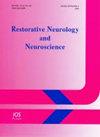Complex housing partially mitigates low dose radiation-induced changes in brain and behavior in rats.
IF 1.6
4区 医学
Q4 NEUROSCIENCES
引用次数: 0
Abstract
PURPOSE In recent years, much effort has been focused on developing new strategies for the prevention and mitigation of adverse radiation effects on healthy tissues and organs, including the brain. The brain is very sensitive to radiation effects, albeit as it is highly plastic. Hence, deleterious radiation effects may be potentially reversible. Because radiation exposure affects dendritic space, reduces the brain's ability to produce new neurons, and alters behavior, mitigation efforts should focus on restoring these parameters. To that effect, environmental enrichment through complex housing (CH) and exercise may provide a plausible avenue for exploration of protection from brain irradiation. CH is a much broader concept than exercise alone, and constitutes exposure of animals to positive physical and social stimulation that is superior to their routine housing and care conditions. We hypothesized that CHs may lessen harmful neuroanatomical and behavioural effects of low dose radiation exposure. METHODS We analyzed and compared cerebral morphology in animals exposed to low dose head, bystander (liver), and scatter irradiation on rats housed in either the environmental enrichment condos or standard housing. RESULTS Enriched condo conditions ameliorated radiation-induced neuroanatomical changes. Moreover, irradiated animals that were kept in enriched CH condos displayed fewer radiation-induced behavioural deficits than those housed in standard conditions. CONCLUSIONS Animal model-based environmental enrichment strategies, such as CH, are excellent surrogate models for occupational and exercise therapy in humans, and consequently have significant translational possibility. Our study may thus serve as a roadmap for the development of new, easy, safe and cost-effective methods to prevent and mitigate low-dose radiation effects on the brain.复杂的住房部分减轻了低剂量辐射引起的大鼠大脑和行为的变化。
目的近年来,人们在制定预防和减轻辐射对健康组织和器官(包括大脑)不利影响的新战略方面做了大量工作。尽管大脑具有高度的可塑性,但它对辐射的影响非常敏感。因此,有害的辐射效应可能是潜在可逆的。由于辐射暴露会影响树突空间,降低大脑产生新神经元的能力,并改变行为,因此缓解措施应侧重于恢复这些参数。为此,通过复合住房(CH)和锻炼来丰富环境可能为探索脑辐射保护提供了一种可行的途径。CH是一个比单独运动更广泛的概念,它包括使动物暴露于积极的身体和社会刺激,这优于它们日常的住房和护理条件。我们假设CHs可能减轻低剂量辐射暴露对神经解剖和行为的有害影响。方法对饲养在环境富集公寓和标准住房的大鼠进行低剂量头部、旁观者(肝脏)和散射辐射照射后的脑形态进行分析和比较。结果丰富的公寓条件改善了辐射引起的神经解剖改变。此外,与饲养在标准条件下的动物相比,饲养在富含CH的公寓中的受辐射动物表现出较少的辐射引起的行为缺陷。结论基于动物模型的环境富集策略,如CH,是人类职业和运动治疗的优秀替代模型,因此具有重要的转化可能性。因此,我们的研究可以作为开发新的、简单的、安全的、经济有效的方法来预防和减轻低剂量辐射对大脑的影响的路线图。
本文章由计算机程序翻译,如有差异,请以英文原文为准。
求助全文
约1分钟内获得全文
求助全文
来源期刊
CiteScore
5.40
自引率
3.60%
发文量
22
审稿时长
>12 weeks
期刊介绍:
This interdisciplinary journal publishes papers relating to the plasticity and response of the nervous system to accidental or experimental injuries and their interventions, transplantation, neurodegenerative disorders and experimental strategies to improve regeneration or functional recovery and rehabilitation. Experimental and clinical research papers adopting fresh conceptual approaches are encouraged. The overriding criteria for publication are novelty, significant experimental or clinical relevance and interest to a multidisciplinary audience. Experiments on un-anesthetized animals should conform with the standards for the use of laboratory animals as established by the Institute of Laboratory Animal Resources, US National Academy of Sciences. Experiments in which paralytic agents are used must be justified. Patient identity should be concealed. All manuscripts are sent out for blind peer review to editorial board members or outside reviewers. Restorative Neurology and Neuroscience is a member of Neuroscience Peer Review Consortium.

 求助内容:
求助内容: 应助结果提醒方式:
应助结果提醒方式:


